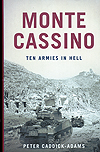
Monte Cassino: Ten Armies in Hell, by Peter Caddick-Adams, Oxford University Press USA, New York, 2013, $29.95
The four months of fighting at the German stronghold of Monte Cassino, the Italian town and monastery that dominate the Liri Valley pathway to Rome from the south, cost the 10 armies that fought there some 75,000 casualties between January and May 1944. British historian Major Peter Caddick-Adams—a lecturer at the United Kingdom Defence Academy who has served in the Territorial Army in Bosnia, Iraq and Afghanistan—has produced a carefully researched, well-written and often movingly poignant account of that hellish clash of World War II.
Debate still rages over whether the Allies were right to bomb the monastery—built circa 529 by St. Benedict himself—to rubble, not only on aesthetic grounds but also because the Germans defended the rubble even better than they had the intact edifice. Monte Cassino was the key nodal point of the Germans’ Gustav Line, and the author explains how the four great waves of Allied assaults made upon it fit into the wider strategy of the war. Caddick-Adams is equally at home with the personal stories of men enduring World War I–style fighting as he is with explaining the thinking behind the decisions made by the German High Command.
Having walked the battlefield many times over several years, Caddick-Adams is also capable of relating the significance of the contour lines on his maps, a vital attribute of an authoritative military history—and a skill that could mean the difference between life and death in battle.
—Andrew Roberts




